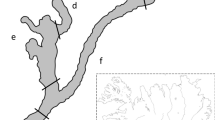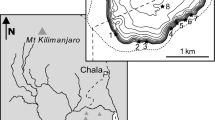Abstract
In aquatic systems, tilapia introductions may result in marked changes in the structure of prey communities. In this study, we experimentally examined the effects of tilapia-mediated water at the individual and population levels of prey by exposing three Daphnia species to predation cues. We hypothesized that tilapia-mediated water determines reduced age and size at primipara, greater and faster reproduction, enhanced intrinsic rates of population increase (r), and longer tail spines in Daphnia; but that the magnitude of these changes would be species and clone-dependent. When three tropical D. laevis and one temperate D. similis clones were exposed to predation cues, adaptive changes were observed in some of the aforementioned parameters for each clone. The three D. laevis clones exhibited changes in all life-history and morphological measures. Temperate Daphnia spinulata displayed no changes but decreased r values in the presence of predators. The observed changes in the species and clones tested here suggest that, overall, both temperate and tropical Daphnia can detect and adaptively react to the risk of tilapia predation. However, only a fraction of the possible defenses may be displayed by individual clones. In contrast, D. spinulata seems more vulnerable to tilapia predation, given its long body length and absence of adaptive changes. Our study indicates that Daphnia can respond to tilapia-mediated water, and that interspecific and clonal variation exists between temperate and tropical species.




Similar content being viewed by others
References
Attayde JL, Menezes RF (2008) Effects of fish biomass and planktivore type on plankton communities. J Plankton Res 30:885–892
Boersma M, Spaak P, De Meester L (1998) Predator-mediated plasticity in morphology, life history, and behavior of Daphnia: the uncoupling of responses. Am Nat 152:237–248
Bronmark C, Hansson LA (2000) Chemical communication in aquatic systems: an introduction. Oikos 88:103–109
Canonico GC, Arthington AH, McCrary JK, Thieme ML (2005) The effects of introduced tilapias on native biodiversity. Aquat Conserv 15:463–483
Carter MJ, Silva-Flores P, Oyanedel JP, Ramos-Jiliberto R (2013) Morphological and life-history shifts of the exotic cladoceran Daphnia exilis in response to predation risk and food availability. Limnologica 43:203–209
Castro BB, Consciência S, Gonçalves F (2007) Life history responses of Daphnia longispina to mosquito fish (Gambusia holbrooki) and pumpkinseed (Lepomis gibbosus) kairomones. Hydrobiologia 594:165–174
Chivers DP, Smith RJF (1998) Chemical alarm signalling in aquatic predator–prey systems: a review and prospectus. Ecoscience 5:338–352
De Meester L, Weider LJ, Tollrian R (1995) Alternative antipredator defenses and genetic-polymorphism in a pelagic predator–prey system. Nature 378:483–485
Dzialowski AR, Lennon JT, O’Brien WJ, Smith VH (2003) Predator-induced phenotypic plasticity in the exotic cladoceran Daphnia lumholtzi. Freshw Biol 48:1593–1602
Elhigzi FAR, Haider SA, Larsson P (1995) Interactions between Nile tilapia (Oreochromis niloticus) and cladocerans in ponds (Khartoum, Sudan). Hydrobiologia 307:263–272
Eskinazi-Sant’Anna EM, Schettino M, Menéndez RM, Guimarães AS, Maia-Barbosa PM (2010) Use of Daphnia spinulata Birabén, 1927 (Crustacea, Cladocera) in the aquarium trade: a potential risk of a new bioinvasion into Brazilian continental waters. Acta Limnol Bras 22:102–104
Esselman PC, Schmitter-Soto JJ, Allan JD (2013) Spatiotemporal dynamics of the spread of African tilapias (Pisces: Oreochromis spp.) into rivers of northeastern Mesoamerica. Biol Invasions 15:1471–1491
Fisk DL, Latta LC, Knapp RA, Pfrender ME (2007) Rapid evolution in response to introduced predators I: rates and patterns of morphological and life-history trait divergence. BMC Evol Biol 7:22
Gurgel JJS, Fernando CH (1994) Fisheries in semi-arid northeast Brazil with special reference on the role of tilapias. Int Rev Gesamten Hydrobiol 79:77–94
Hedges LV, Gurevitch J, Curtis PS (1999) The meta-analysis of response ratios in experimental ecology. Ecology 80:1150–1156
Kaliszewicz A, Uchmański J (2009) A cross-phyla response to Daphnia chemical alarm substances by an aquatic oligochaete. Ecol Res 24:461–466
Laforsch C, Ngwa W, Grill W, Tollrian R (2004) An acoustic microscopy technique reveals hidden morphological defenses in Daphnia. Proc Natl Acad Sci USA 101:15911–15914
Laforsch C, Beccara L, Tollrian R (2006) Inducible defenses: the relevance of chemical alarm cues in Daphnia. Limnol Oceanogr 51:1466–1472
Lazzaro X (1987) A review of planktivorous fishes: their evolution, feeding behaviours, selectivities, and impacts. Hydrobiologia 146:97–167
Loose CJ, Von Elert E, Dawidowics P (1993) Chemically-induced diel vertical migration in Daphnia—a new bioassay for kairomones exuded by fish. Arch Hydrobiol 126:329–337
Machacek J (1993) Comparison of the response of Daphnia galeata and Daphnia obtusa to fish-produced chemical substance. Limnol Oceanogr 38:1544–1550
Maszczyk P, Bartosiewicz M (2012) Threat or treat: the role of fish exudates in the growth and life history of Daphnia. Ecosphere 3:91
Menezes RF, Attayde JL, Vasconcelos FR (2010) Effects of omnivorous filter-feeding fish and nutrient enrichment on the plankton community and water transparency of a tropical reservoir. Freshw Biol 55:767–779
Meyer JS, Ingersoll CG, McDonald LL, Boyce MS (1986) Estimating uncertainty in population growth rates—Jackknife vs Bootstrap techniques. Ecology 67:1156–1166
Ortega JCG, Júlio HF, Gomes LC, Agostinho AA (2015) Fish farming as the main driver of fish introductions in neotropical reservoirs. Hydrobiologia 746:147–158
Pestana JLT, Baird DJ, Soares AMVM (2013) Predator threat assessment in Daphnia magna: the role of kairomones versus conspecific alarm cues. Mar Freshw Res 64:679–686
Petrusek A, Tollrian R, Schwenk K, Haas A, Laforsch C (2009) A “crown of thorns” is an inducible defense that protects Daphnia against an ancient predator. Proc Natl Acad Sci USA 106:2248–2252
Pijanowska J, Dawidowicz P, Howe A, Weider LJ (2006) Predator-induced shifts in Daphnia life-histories under different food regimes. Arch Hydrobiol 167:37–54
Rabus M, Sollradl T, Clausen-Schaumann H, Laforsch C (2013) Uncovering ultrastructural defenses in Daphnia magna—an interdisciplinary approach to assess the predator-induced fortification of the carapace. PLoS One 8:e67856
Rosenberg MS, Adams DC, Gurevitch J (2000) MetaWin: statistical software for meta-analysis. Version 2.0. Sunderland, Massachussets: Sinauer Associates
Sarma SSS, Nandini S, Gulati RD (2005) Life history strategies of cladocerans: comparisons of tropical and temperate taxa. Hydrobiologia 542:315–333
Scheiner SM (1993) MANOVA: Multiple response variables and multispecies interactions. In: Gurevitch J, Scheiner SM (eds) Design and analysis of ecological experiments. Chapman and Hall, London, pp 94–112
Scheiner SM, Gurevitch J (2001) Design and analysis of ecological experiments, 2nd edn. Oxford University Press, Oxford
Schoeppner NM, Relyea RA (2005) Damage, digestion, and defence: the roles of alarm cues and kairomones for inducing prey defenses. Ecol Lett 8:505–512
Scoville AG, Pfrender ME (2010) Phenotypic plasticity facilitates recurrent rapid adaptation to introduced predators. Proc Natl Acad Sci USA 107:4260–4263
Spaak P, Vanoverbeke J, Boersma M (2000) Predator-induced life-history changes and the coexistence of five taxa in a Daphnia species complex. Oikos 89:164–174
StatSoft (2007) STATISTICA (data analysis software system), version 7.0. PhysicsWeb. www.statsoft.com. Accessed 10 June 2014
Stemberger RS (1981) A general approach to the culture of planktonic rotifers. Can J Fish Aquat Sci 38:721–724
Stibor H (1992) Predator induced life-history shifts in a fresh-water cladoceran. Oecologia 92:162–165
Swaffar SM, O’Brien WJ (1996) Spines of Daphnia lumholtzi create handling difficulties for juvenile bluegill sunfish (Lepomis macrochirus). J Plankton Res 18:1055–1061
Vitule JRS, Freire CA, Simberloff D (2009) Introduction of non-native freshwater fish can certainly be bad. Fish Fish 10:98–108
von Elert E, Pohnert G (2000) Predator specificity of kairomones in diel vertical migration of Daphnia: a chemical approach. Oikos 88:119–128
Weber A (2003) More than one ‘fish kairomone’? Perch and stickleback kairomones affect Daphnia life history traits differently. Hydrobiologia 498:143–150
Weber A, Van Noordwijk A (2002) Swimming behaviour of Daphnia clones: differentiation through predator infochemicals. J Plankton Res 24:1335–1348
Yin MB, Laforsch C, Lohr JN, Wolinska J (2011) Predator-induced defense makes Daphnia more vulnerable to parasites. Evolution 65:1482–1488
Zambrano L, Martinez-Meyer E, Menezes N, Peterson AT (2006) Invasive potential of common carp (Cyprinus carpio) and Nile tilapia (Oreochromis niloticus) in American freshwater systems. Can J Fish Aquat Sci 63:1903–1910
Acknowledgments
We thank the staff of Fiocruz for assistance during the experiment. We also thank Adriano Caliman (UFRN), who kindly calculated the effect sizes. Financial support for this project was provided by Fundação Carlos Chagas Filho de Amparo à Pesquisa do Estado do Rio de Janeiro (FAPERJ), No. E-26/110.404/2011, and a fellowship to M. Tolardo was provided by Coordenação de Aperfeiçoamento de Pessoal de Nível Superior (CAPES).
Author information
Authors and Affiliations
Corresponding author
About this article
Cite this article
Tolardo, M., da Silva Ferrão-Filho, A. & Santangelo, J.M. Species and clone-dependent effects of tilapia fish (Cichlidae) on the morphology and life-history of temperate and tropical Daphnia . Ecol Res 31, 333–342 (2016). https://doi.org/10.1007/s11284-016-1337-z
Received:
Accepted:
Published:
Issue Date:
DOI: https://doi.org/10.1007/s11284-016-1337-z




